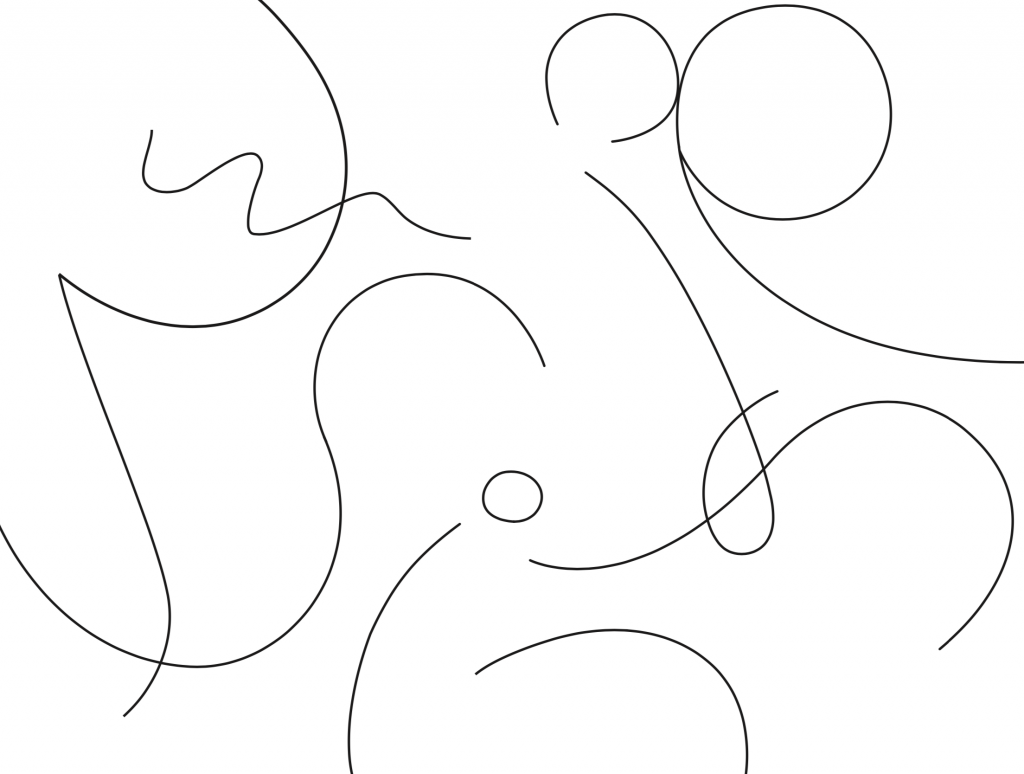Ilke Gers
Postscript
16.02.2020 — 15.03.2020
Opening: 16.02.20 van 15:00 – 18:00
15:00: Performance
16:00: Conversation with Valentijn Goethals
17.02.20 – 23.02.20
Uitzonderlijk dagelijks geopend van 14:00 – 18:00
Exceptionally open daily from 2pm until 6pm
27.02.20 – 15.03.20
Open van do-zo 14:00 – 18:00 en op afspraak
Open from Thu-Sun 2pm until 6pm and by appointment
[NL]
De Nieuw-Zeelandse Ilke Gers (1981) met Ierse en Duitse voorouders (achternaam uit te spreken als [gɜ:z]) omschrijft haar werkmethode als “site-sensitive”. Waar men bij site-specific ervan zou kunnen uitgaan dat de omgeving het werk mee vormgeeft, gaat het bij Gers erom hoe een ruimte aanvoelt. De aandacht gaat naar het poreuze aspect ervan. Ze brengt haar eigen ideeën, interesses, bedenkingen en materiaal in de ruimte, maar is er attent op ze niet te overweldigen.
Het is dan ook geen toeval dat één van de minst blijvende materialen haar favoriete gerief is: krijt. Een bouwstof die zonder toevoeging van een ander middel tot geen enkele hardheid vermag, een grondstof par excellence om tijdelijke markeringen te maken. Haar fascinatie voor tekens en taal in de publieke ruimte werd vooral gevoed sinds 2013, na haar studie in Nederland. In Rotterdam, waar ze woont en werkt, zijn (verkeers)regels en wetten door tekst en wegmarkeringen overvloedig aanwezig. De openbare en publieke ruimte lijkt volledig in kaart gebracht, gestructureerd, gedefinieerd en bijgevolg gecontroleerd te zijn.
Het uitgangspunt van Gers’ visueel werk is schrift.
Letters en delen van lettertekens zijn minimale overblijfselen van een verteld verhaal, van informatie over een plaats, een visualisatie van een subjectieve herinnering.
De titel “postscript” in de betekenis van postscriptum (Lat. “naschrift”) vat het op een andere manier samen: niet de inhoud van de brief speelt een rol, maar de korte, informele, persoonlijke informatie die na de handtekening staat, is het thema van deze tentoonstelling.
Gers heeft zich verdiept in de geschiedenis van wie er vroeger in de Paleisstraat leefde of er een zaak uitbaatte, hoe de straat en de buurt door de jaren heen veranderde en hoe het sociale weefsel tussen buurtbewoners, middenstand, de vele scholen en de verschillende religies van de meer dan 30.000 bewoners van de wijk “Brederode” zich de voorbije decennia ontwikkelde. Boeiend is, dat hoewel het postscriptum niet tot de eigenlijke inhoud van de brief hoort, het vaak het eerst en meest de aandacht trekt omdat het apart gezet is.
“PostScript” daarentegen is eveneens een programmeertaal om tekst en afbeeldingen te beschrijven, en ook (misschien vooral) deze betekenis komt zeer dicht bij de kern van wat Ilke Gers met haar performances en krijttekeningen doet. Is schrijven zonder taal tekenen?
De (in onbruik geraakte) betekenis van het werkwoord ‘lijnen’ als vakterm voor lijnen maken, ‘krijten’ als werkwoord voor met krijt werken, het Engelse ‘to chalk’ of ‘to trace’ omschrijven haar kunst het meest accuraat. Gers verbindt een vorm van schrijven/(tekenen) met een fysieke activiteit, start een lijn zonder op voorhand te weten waar ze eindigt.
Tijd en activiteit worden op een intuitieve wijze met elkaar verbonden en bepalen het residu, dat vanaf dan verzelfstandigt tot een tijdelijk beeldend werk.
Stella Lohaus, februari ’20
U kan de zaaltekst hier downloaden.
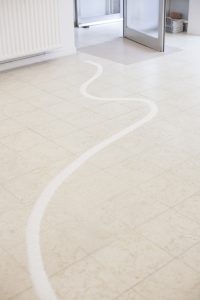

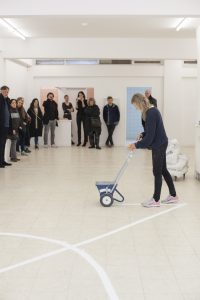

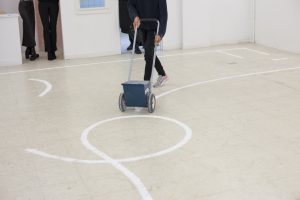
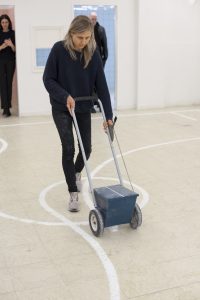
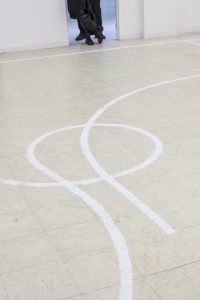
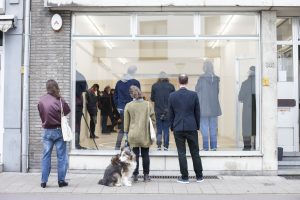
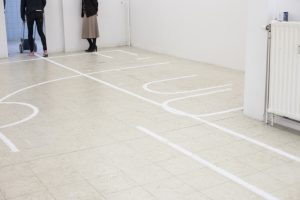
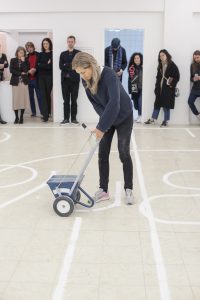
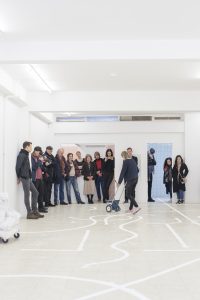
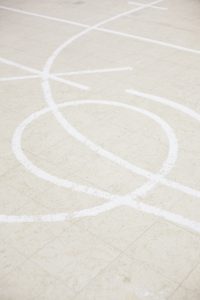
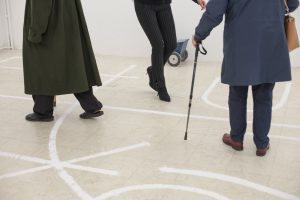
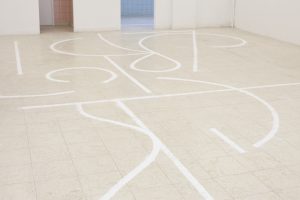

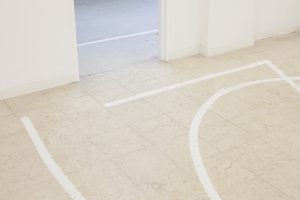
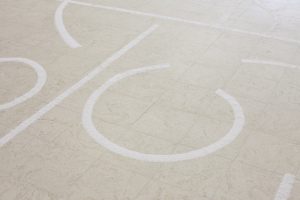
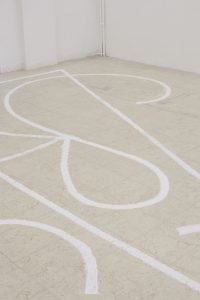
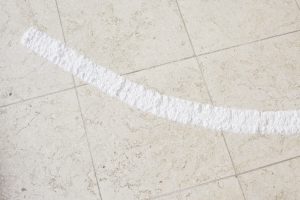
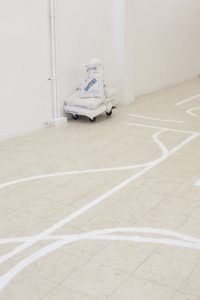
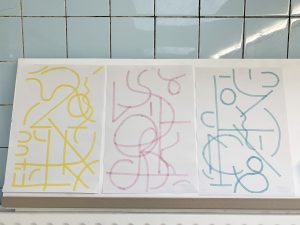
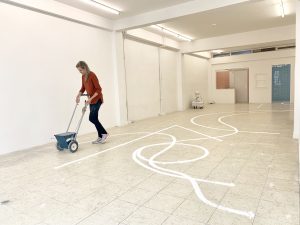
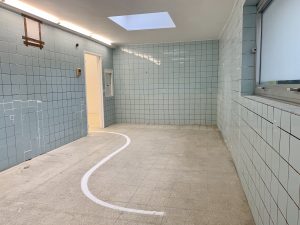
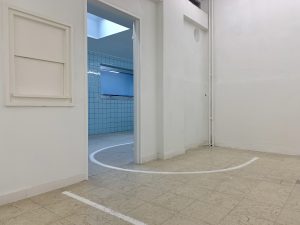
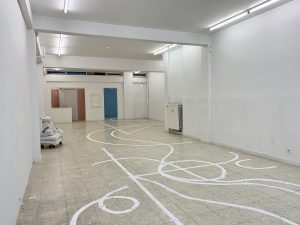
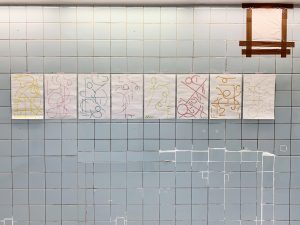
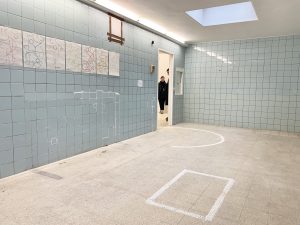
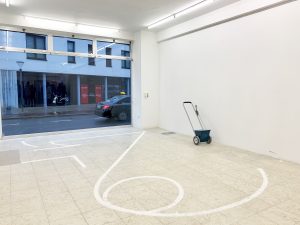
[EN]
The New Zealand artist Ilke Gers (1981) with Irish and German roots describes her working method as “site-sensitive”. When site-specific suggests that the site shapes the work, Gers is more concerned with how a space feels. The attention goes to the more porous aspect of it. She brings her own ideas, interests, concerns and material into the space, but she is cautious not to overpower it.
So it can’t be a coincidence that one of the least permanent materials is her favourite tool: chalk. A building material that without adding another element (air, water, …) can’t reach a state of hardness. In other words: a raw material par excellence to make temporal markings. Her fascination for signs and language in public space grew since 2011, while studying in the Netherlands. In Rotterdam, where she currently lives and works; traffic rules, public notices and laws, and road marks are abundant. Public space seems fully recorded, structured, defined and eventually controlled.
All Gers’s visual work comes from writing.
Characters and parts of characters are minimal left-overs of a story once told, of information about a place or space, a visualisation of a subjective recollection.
The title “Postscript”, derived from Latin, implies that it is not the content of the letter which is important, but the short, informal, personal information, the addendum following the signature is the theme of this exhibition.
Gers investigates the history of the building; the previous inhabitants and businesses that where in the Paleisstraat, how the neighbourhood changed as time went by, and how the social fabric between local residents, small self-employed shopkeepers, the many schools and the different religions of more than 30.000 residents in the area “Brederode” developed the past decennia. It is fascinating that although the postscriptum does not belong to the real content of the letter, it is often read first, drawing most attention because it is set aside.
“PostScript” on the contrary is also a coding language to describe text and image, and this aspect probably comes quite closely to the core of what Ilke Gers is doing in her performances with her chalk work. Is writing without language drawing? If we transform the nouns ‘chalk’, ‘trace’, ‘line’, ‘stripe’ into verbs, we come close to what Ilke Gers does as an artist: she chalks, traces, lines, stripes, … Gers connects a form of writing/(drawing) with a physical activity, she starts a line without knowing in advance where she/it will end.
Time and activity are intuitively intertwined and determine the residue, that then becomes an independant temporal visual artwork.
Stella Lohaus, February ’20
You can download the text here.
Met de steun van / with the support of de Vlaamse Overheid en District Antwerpen.
Met dank aan / with thanks to Dora Brams, Paula Brey, Moniek Buyle, Christophe Clarijs, Eline De Clercq, Geert Gielis, Valentijn Goethals, Miles Fischler, Sun Mee Hooremans, Ferrat Hurdogan, Izzet Hurdogan van Bakkerij Lazo, Rufus Michielsen, Ria Pacquée, de bewoners van Palacio, Bodo Peeters, Griet Rombaut, Vincent Stroep, Joost Van Langendonck, Frederic Verlinden.
Gesponsord door / sponsored by Duvel Moortgat, Sampa Tea Company en All Printing Services.
